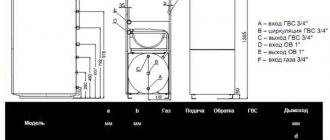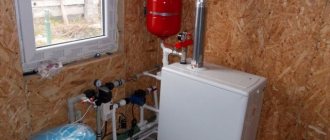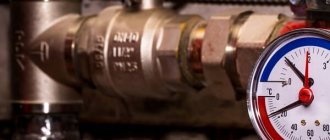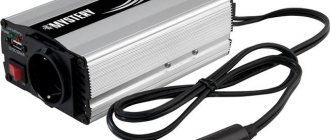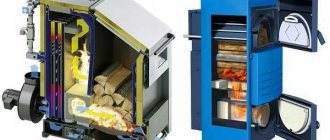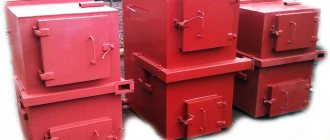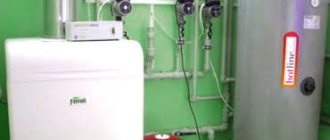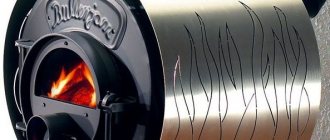General characteristics of a gas floor boiler
Floor-standing gas boilers are easier to maintain due to the lack of built-in automation
Gas boilers are available in several modifications. They can be floor or wall. Wall-mounted ones are characterized by compact dimensions and good performance characteristics. But most often in private homes they give preference to installing floor equipment. This is due to its positive properties:
- Great power. The designs of these devices can produce more power than wall-mounted models.
- You can find non-volatile models that will work with coolant moving without using a pump.
- Long service life of the equipment. With properly selected parameters and proper installation, the boiler can operate for more than 50 years.
- Cost-effective and easy to maintain. Floor-standing boilers, unlike wall-mounted ones, are produced without built-in automation. They also do not have additional equipment. This reduces functions, but significantly simplifies maintenance and repair, and increases service life.
Installing gas boilers also has its disadvantages. According to safety regulations, the device must be located in a separate room. There are a number of requirements for the premises that must be strictly observed. If the boiler room does not comply with them, it will be impossible to obtain permission to start gas equipment.
How does a gas boiler depend on automation?
Since power outages often occur, it is very important that the gas boiler continues to work. You can use a heat generator that will generate electricity from the heat that will be needed for the operation of the automation. The second option is independence from electricity. And this can only be done in the complete absence of automation.
There are several power options for gas boilers: single-stage, two-stage and with continuously adjustable power.
Single-stage boilers are boilers that operate at one power level.
Two-stage boilers are boilers that have two power levels.
The best option would be a two-stage or continuously variable boiler, since the full power is needed at about 20% for the entire heating season.”
Advantages of two-stage boilers:
1. Small amount of flue gas and harmful substances. 2. Boilers of various capacities can be used. 3. The service life is increased due to the rare switching on and off of the burner. Due to frequent operation at low power and rare switching on and off, gas is saved.
Types of floor-standing gas boilers
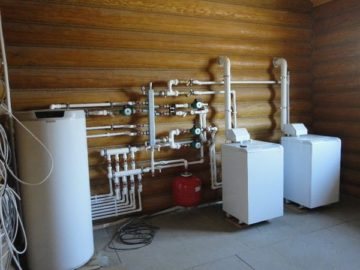
Single-circuit heating boilers with a boiler for heating water
A floor-standing gas boiler can be single-circuit or double-circuit.
Single-circuit
With a single-circuit device, the boiler will heat only the coolant and function as a heating device.
The equipment is equipped with one heat exchanger. Thanks to this, its design is simplified and its dimensions are reduced. However, if water heating is necessary, you will need to purchase additional equipment. Most often, in such a situation, an indirect heating boiler is installed. Heating gas single-circuit floor-standing boilers are selected for buildings that do not require hot water supply. They are also used for large areas where all the power is used to heat the building.
Dual-circuit
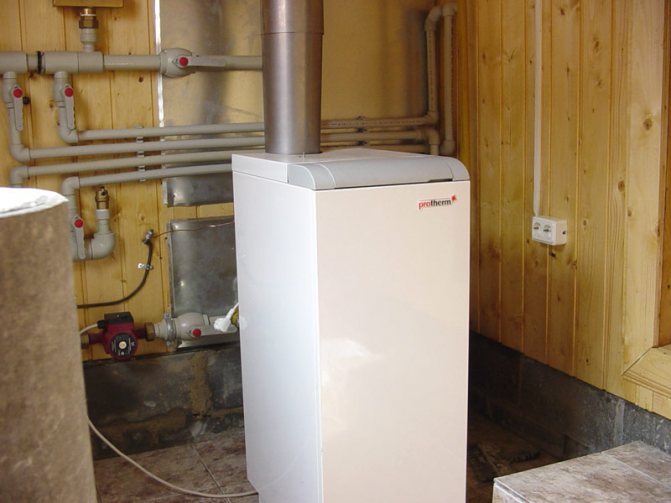
Double-circuit gas floor-standing boiler for heating and water heating
A floor-standing gas double-circuit boiler is a more complex design. It is designed to heat the coolant and provide the home with hot water. Dual-circuit devices have two heat exchangers built in.
Manufacturers produce models with bithermic heat exchangers, which are divided into segments. Along one of them the coolant moves and the other heats up water. Such devices will be the most compact, but they are less reliable in operation.
It is optimal to purchase a unit with two completely separate heat exchangers. They form less scale. The circuits will be separated, so there is no need to turn off the heating when distributing hot water.
Double-circuit boilers are best suited for small buildings. If such a device is used for large areas, separation of the circuits will be required. This is necessary for safety reasons.
Advantages and disadvantages
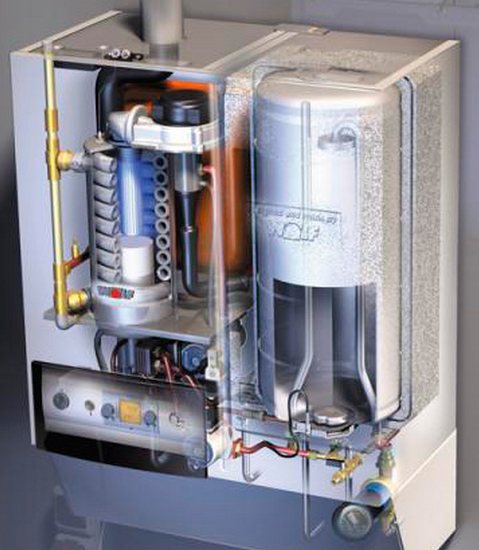
Single-circuit boilers may have small built-in boilers for storing hot water
Depending on the design features, a floor-standing boiler has its positive and negative sides.
With built-in boiler
Single-circuit boilers with a boiler have a number of advantages:
- Large internal cross-section of the heat exchanger. This reduces the formation of scale.
- The simplicity of the design ensures a high level of reliability.
- Thermal energy consumption will be the most rational.
- The water inside the boiler always has the same temperature, since it is not affected by pressure surges in the gas line.
- The “boiler and gas boiler” set will fully provide hot water and heat to the entire building.
The downside is that the correct operation of the boiler depends on the quality of the water, which most often does not meet the standard.
With cast iron heat exchanger

Cast iron heat exchangers are more expensive, but have more advantages
Boilers with a cast iron heat exchanger have the following advantages:
- Durable and resistant to corrosion.
- The material ensures uniform heat distribution.
- Cast iron has excellent technical properties.
- The material is resistant to environmental influences.
- The cast iron heat exchanger is able to withstand high temperatures.
- The material has a long service life.
The disadvantages of cast iron heat exchangers include:
- heavy weight, which makes transportation difficult;
- cast iron is afraid of temperature changes - if water gets on the hot material, it may burst;
- It is very difficult to move a boiler with a cast iron heat exchanger, since the material is fragile and can crack if accidentally dropped.
Cast iron heat exchangers are installed only on floor-standing boilers.
Non-volatile
The main advantage of non-volatile boilers is that there is no need to connect electricity. Due to the minimum number of components, the device is very compact and easy to install. Double-circuit floor-standing, non-volatile boilers are capable of providing a home with hot water and full heating in areas with unstable energy supplies.
Devices of this type will only work well if there is sufficient pressure in the gas line. This point is a minus.
How does a gas heating boiler work?
For normal operation of a gas boiler, liquefied or natural gas is usually used. As a result of combustion, it gives off its heat inside the structure, i.e. heat exchanger. The water is heated through a heat exchanger and passes into the heating system.
To select a gas boiler, you need to study all the characteristics in more detail.
For high-quality operation of the boiler, there must be a good heat exchanger. It is made from different materials: copper, steel and cast iron. The service life and quality of operation of the heating boiler depend on the choice of material.
- A copper heat exchanger is very expensive, so it is rarely used. There are some models on sale, but not many. In addition, such heat exchangers quickly burn out.
- The steel heat exchanger has great mechanical strength, low weight, and is also quite resistant to cracks or deformations. But a steel heat exchanger, just like a copper one, quickly burns out. Depending on the quality of the steel, the service life is 10 years.
- The cast iron heat exchanger does not corrode, is durable and burns out less often. Despite all the advantages, it is very fragile. Even changes in water temperature or shock can damage its body. The service life of a cast iron heat exchanger is over 50 years.
Selection requirements
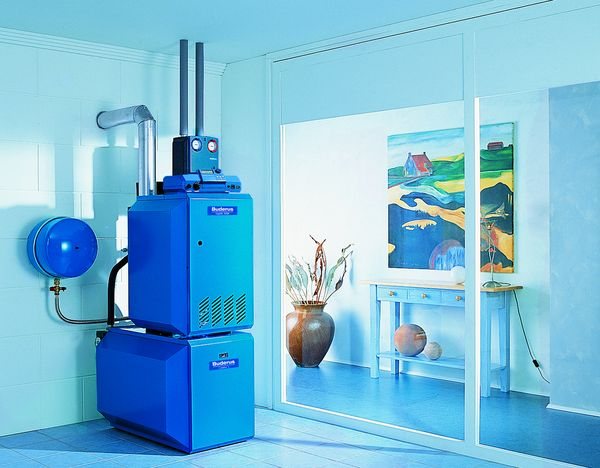
Floor-standing gas boilers have more power than wall-mounted ones and require a separate room for installation
When choosing a gas boiler for your home, you need to take into account a number of nuances that are related to the technical characteristics of the building, as well as the installed heating system. You should pay attention to the following parameters:
- Power. Defines the maximum area that the device can heat. If it is not enough, the service life of the boiler will be reduced due to premature wear of parts. If a double-circuit gas boiler is purchased, 25% is added to the power required to heat all rooms.
- Fuel consumption. In this situation, preference should be given to units that have electric ignition, which reduces fuel consumption.
- Heat exchanger material. Devices in which a cast iron element is installed have a longer service life.
- Possibility of regulating power consumption.
- Performance. Relevant for double-circuit floor-standing gas boilers and depends on the number of people living in the house.
- Maximum hot water heating temperature. Most often it varies from 80 to 90 degrees.
The dimensions of the gas boiler are selected taking into account the location of its installation. When choosing equipment, it is also recommended to pay attention to additional functions and capabilities. They are aimed at increasing the level of security.
- Protection against overheating and freezing. This is the most relevant function for purchasing a heater for country houses where no one lives in the winter.
- Gas control system. It involves installing sensors that will turn off equipment in the absence of gas supply.
If you plan to organize hot water supply, you should choose models with two circuits.
Number of circuits
Depending on whether you need hot water supply, a single-circuit or double-circuit model is selected. The latter will not only heat the room, but also provide you with hot water. Double-circuit gas devices are distinguished by the presence of two heat exchangers : one for heating, the other for providing hot water supply. Such devices include the following components: a boiler, a burner and an automation system.
…
When choosing double-circuit floor-standing gas boilers, you should decide on the volume of hot water consumption.
If you are satisfied with the DHW capacity of up to 15 liters per minute at t=30ºC, you can purchase a flow-type heating device. The principle of their operation is this: water from the water supply passes through the heating system and is supplied from the tap. Such gas boilers are more compact in size when compared with units equipped with boilers. They are mounted above gas boilers or installed nearby to store large volumes of hot water from 50 to 200 liters. Note! The presence of a boiler will allow you to have a supply of heated water even when the gas is turned off.
If you want to purchase a 60 kW Buderus floor-standing boiler
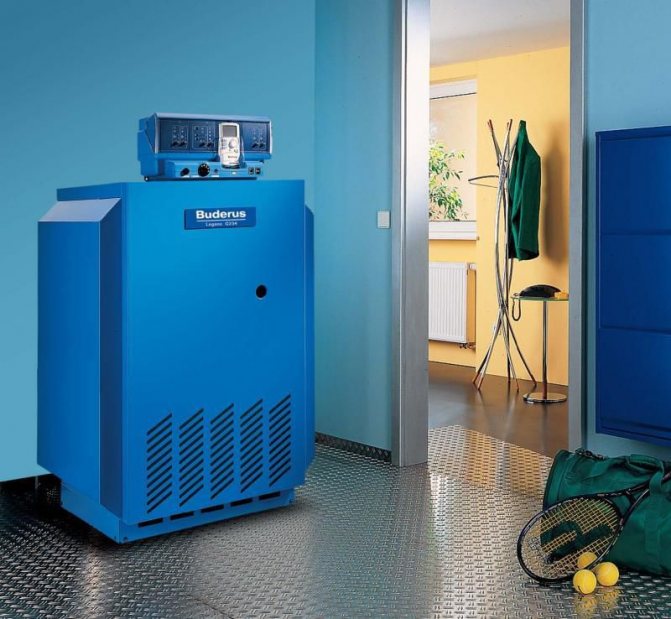
Find out about floor-standing gas units of domestic production here Ventilation for a gas boiler in a private house
Types of burners
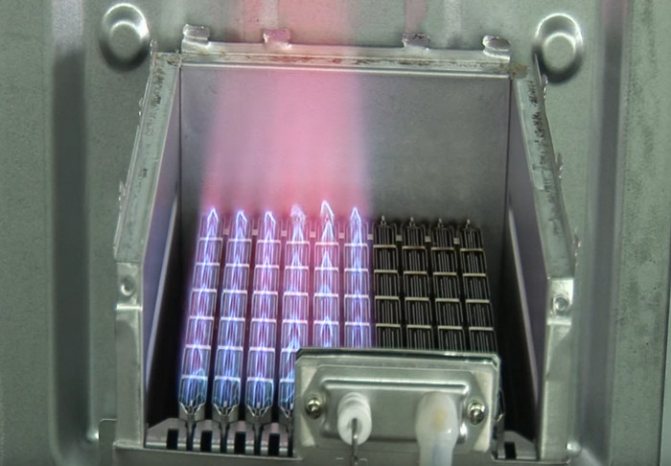
Atmospheric burners take oxygen from the room
Burners of floor-standing boilers are divided into one-stage, two-stage and modulating. Single-stage systems assume that the device can produce only one power level; with a two-stage system, it is selected from two levels. Modulation regulates the available power. The efficiency of the equipment depends on the type of burners.
Inflatable burners are equipped with turbines for heating. They take air from the room and from the street. They do not require a separate room.
Atmospheric burners are one of the most reliable at an affordable price. Their disadvantage is considered to be air burning and low efficiency.
Removal of combustion products
Depending on the type of burner, the smoke removal method is selected. If the gas boiler is equipped with an atmospheric burner (open type), for which air is taken from the room, then the installation of a classic chimney will be required. If the unit is equipped with a turbocharged burner (closed type), then installing a compact coaxial chimney will be sufficient. It will ensure the supply of oxygen necessary for the combustion process, as well as convenient smoke removal.
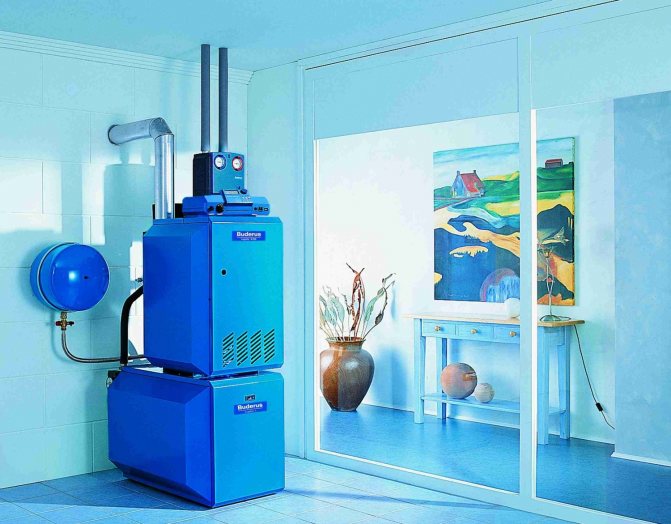
Note! For floor-standing boilers with an atmospheric burner, a separate room (boiler room) will be required, and units with a closed chamber can be installed in the living room.
The efficiency of gas boilers with a closed burner is higher than with an open one.
Dependence on automation
In gas heating equipment, automation plays the role of additional security. Thanks to special functions, the operation of the devices becomes more reliable and a constant optimal temperature is maintained.
Automation performs the following tasks:
- turns off the system when gas supply stops;
- regulates the burner power level;
- displays the indicators.
Additional features prevent device damage.
Manufacturers rating
Boilers from the German manufacturer Buderus can be selected according to power parameters for any room
The heating equipment market offers a wide selection of floor-standing gas boilers. When purchasing, it is important to pay attention to manufacturers who are in consumer demand. Many companies use modern innovative developments that allow them to produce devices with excellent operating characteristics. The most popular manufacturers are:
- Lemax. A domestic manufacturer that offers a wide range of floor-standing boilers powered by gas. The main models are “Patriot” and “Leader”. Lemax produces both single- and double-circuit devices.
- Don. A Russian manufacturer that produces powerful devices designed to heat areas of 300 square meters or more. Thanks to the use of high-quality materials and built-in automation, boilers from this manufacturer are widely popular.
- Buderus. A German manufacturer offering premium condensation and convection devices. Boilers are available in a wide range of power.
Purchasing gas equipment to provide space heating and hot water supply is an excellent option for private country houses.
Volatile and non-volatile boilers
Floor-standing gas heating boilers are divided into volatile and non-volatile. The former require a mandatory connection to the electrical network - electronic control modules are used here, and fans are installed to force the removal of flue gases and suck in clean air. Electricity is also required to operate some internal components, such as circulation pumps and three-way valves.
Volatile floor-standing gas boilers operate using electricity. Consumers and experts note that for normal operation of this equipment, stable power is required, without surges. In order to ensure stability, the boilers are connected through stabilizers and uninterruptible power supplies equipped with batteries.
Some trading companies sell special equipment for uninterrupted power supply of gas boilers from solar energy - at night the equipment runs on batteries.
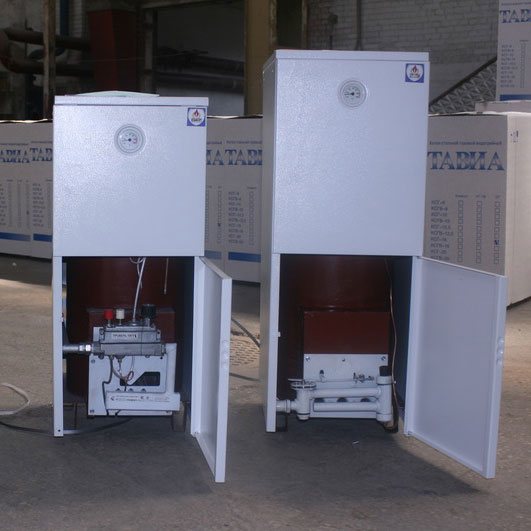
If there are frequent power outages where you live, a non-volatile boiler is the optimal solution.
Non-volatile floor-standing gas boilers have a simplified design. There are no electronics or fans here, no electrical components of any kind. The flame is ignited by a burning igniter or a couple of batteries. They break down less and continue to work even during a power outage. Therefore, they are chosen by many consumers who do not want the operation of the heating system to depend on any factors.

